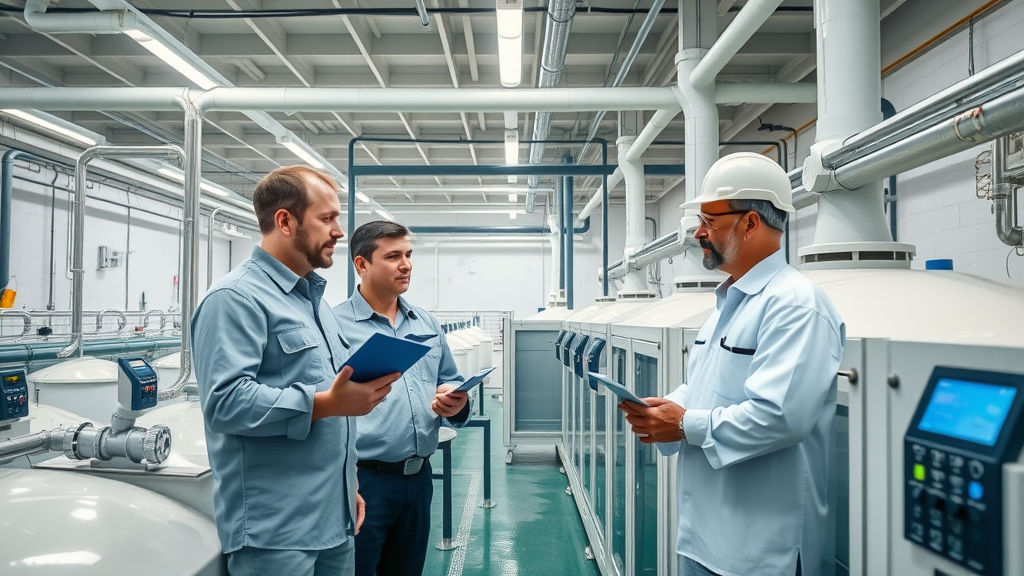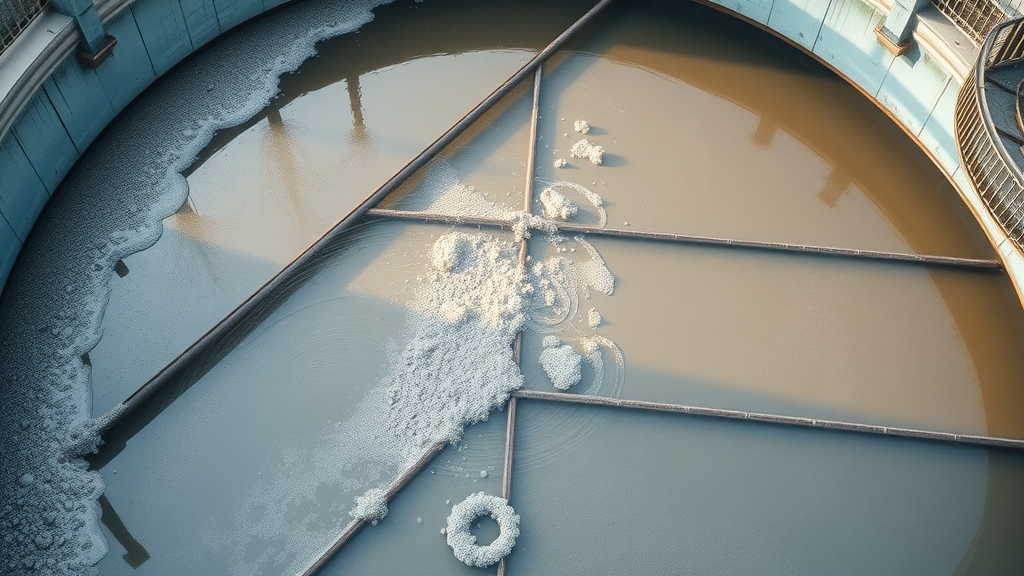Hook: Did you know that an estimated 80% of global wastewater is released untreated into the environment? This shocking statistic highlights just how vital wastewater & sewage treatment plants are—not only for safe water, but also for public health, environmental protection, and sustainable cities. Dive in to uncover how these facilities are transforming our world and what you absolutely need to know.
The Essential Role of Wastewater & Sewage Treatment Plants
Wastewater & sewage treatment plants stand at the frontline of our battle to protect public health, ensure clean water, and safeguard nature. With population growth and expanding cities, water pollution and untreated effluent jeopardize water quality and threaten the delicate balance of aquatic ecosystems. As the world faces mounting water pressures, understanding the function and significance of these treatment plants is more critical than ever. Treatment plants don’t just purify water; they act as economic engines, enabling cities to recover resources, support industries, and pave the way for resilient communities. Their influence goes far beyond pipes and tanks—it’s about creating a liveable, healthier tomorrow.
From the moment water leaves our homes and industries, wastewater treatment plants spring into action. They capture and cleanse water tainted by organic matter, industrial waste, and municipal runoff. Each step, from preliminary screening to advanced tertiary treatment, delivers cleaner water back into natural cycles or for beneficial reuse. Along the way, nutrient removal processes and energy-efficient systems boost operational sustainability and reduce harmful impacts. In this guide, you’ll explore the startling need for effective sewage treatment, the precise treatment process from start to finish, and the powerful technologies shaping the future of water treatment worldwide.
For a closer look at how environmental consulting can enhance the efficiency and compliance of wastewater treatment operations, consider exploring the expertise offered by CSI Environmental Inc. Their tailored solutions support facilities in meeting regulatory standards and implementing best practices for sustainable water management.
The Surprising Statistics That Highlight Our Water Crisis
Globally, the water crisis is exacerbated by the fact that only about 20% of wastewater goes through any form of treatment before re-entering the world’s waterways. Major cities, industrial centers, and even rural communities are impacted by untreated discharges, which contribute to over 1.8 billion people using contaminated water sources for drinking and daily needs. This puts immense pressure on public health, with millions falling ill each year due to waterborne diseases traced back to improper sewage management.
Furthermore, the ripple effect of neglecting wastewater treatment can be seen in algal blooms, loss of fisheries, and the depletion of oxygen in water bodies vital for aquatic life. The economic loss from polluted water often exceeds the investment required for building and maintaining wastewater treatment facilities. As awareness around water scarcity and public health grows, innovative solutions and robust sewage treatment plant designs become cornerstones of sustainable development.

"An estimated 80% of global wastewater is released untreated into the environment, jeopardizing both health and ecosystems." – United Nations Environment Programme
What You'll Learn About Wastewater & Sewage Treatment Plants
Key differences between types of treatment plants
Fundamentals of primary, secondary, and tertiary treatment processes
How nutrient removal and advanced technologies work
Economic and environmental impacts of treatment facilities
Innovations shaping the future of wastewater & sewage treatment plants
Understanding Wastewater & Sewage Treatment Plants
Defining Wastewater & Sewage Treatment Plants
Wastewater & sewage treatment plants are specialized treatment facilities designed to remove contaminants from liquid waste, including domestic, industrial, and municipal sources. These facilities use a range of treatment processes to ensure that water can be safely returned to the environment or reused, supporting both public health and ecological balance. Wastewater treatment plants vary in size and complexity, operating in both urban and rural settings to manage different waste streams.
At their core, these plants implement a treatment system that sequentially removes organic matter, nutrients, pathogens, and pollutants. By applying both physical and biological processes, such as sedimentation, activated sludge, and disinfection, they not only clean water but also reclaim resources like biogas or usable sludge. This integrated approach makes them essential for any sustainable city and a bulwark against water pollution threats.

Importance in Water Treatment and Environmental Health
The importance of wastewater & sewage treatment plants extends beyond simple water purification. They serve as vital cornerstones for improving water quality and protecting environmental health. By intercepting and treating the various types of waste found in municipal and industrial effluents, these treatment plants prevent untreated wastewater from polluting rivers, lakes, and oceans. Such unchecked pollution can trigger outbreaks of disease, affect crop irrigation, and irreparably damage aquatic habitats supporting local economies and biodiversity.
Moreover, effective treatment plants directly contribute to meeting stringent water treatment regulations, ensuring that treated wastewater—now called effluent—is fit for discharge or reuse. Their ability to reduce pathogens, organic load, and harmful nutrients fosters public health, makes recreational water use safer, and helps cities adhere to international environmental commitments. As demand for fresh water rises globally, investment in wastewater treatment plant infrastructure is quickly becoming an essential component of smart water management.
How Wastewater & Sewage Treatment Plants Manage Sources
Domestic, Industrial, and Municipal Waste Overview
Wastewater & sewage treatment plants face the challenge of managing diverse types of waste, each with distinct characteristics and risks. Domestic waste, originating from households, primarily carries organic matter such as food particles, soap, bodily waste, and detergents. Industrial waste introduces a broader range of pollutants, depending on the manufacturing sector—ranging from heavy metals and chemical residues to suspended solids and oils. Municipal waste typically represents a blend, resulting from the aggregation of domestic and commercial discharges across a city.
Each waste source influences the design and operational parameters of a treatment plant. For instance, industrial effluents may require pretreatment to remove hazardous compounds before entering the main treatment system. Addressing these types effectively ensures not only regulatory compliance but also helps maintain optimal plant performance and water quality throughout the treatment cycle. In the table below, explore how these waste sources compare and the key considerations for managing them in water treatment settings.
Comparison of Waste Sources Treated by Wastewater & Sewage Treatment Plants |
|||
Waste Source |
Main Components |
Treatment Challenges |
Typical Applications |
|---|---|---|---|
Domestic |
Organic matter, detergents, nutrients, pathogens |
High organic load, pathogen control |
Residential sewage treatment |
Industrial |
Chemicals, heavy metals, oils, suspended solids |
Toxic substances, process variability |
Industrial wastewater treatment |
Municipal |
Mix of domestic, commercial, and light industrial waste |
Load fluctuations, diverse contaminants |
City-wide water treatment systems |
Key Components of a Treatment Plant: Breaking Down the Process
Primary Treatment in Wastewater & Sewage Treatment Plants
Primary treatment serves as the fundamental step in many wastewater treatment plants. The goal during this stage is to remove large solids, floatable materials, and settleable matter. Wastewater first flows into large sedimentation tanks—sometimes called settling tanks—where gravity naturally allows solids to sink, forming sludge at the bottom, while lighter substances like oil float to be skimmed away. This initial process removes about 50-60% of suspended solids and a significant portion of organic matter, setting the stage for more sophisticated downstream processes.
This primary phase of the treatment process demands durable infrastructure, including grit chambers, screens, and sedimentation basins. Efficient removal of solids in primary treatment improves the performance of biological processes in the next stages and prevents excessive buildup in pipes and equipment across the treatment facility. Facilities constantly monitor this process to ensure optimal sediment separation, making the difference between a robust water treatment system and one vulnerable to operational hiccups and reduced effluent quality.

Secondary Treatment in Treatment Plants
The secondary treatment phase is where biological processes take center stage to further purify the wastewater. This stage involves the use of microorganisms, often in activated sludge systems, to break down dissolved and suspended organic matter that remains after primary sedimentation. Aeration tanks supply the necessary oxygen for bacteria to thrive, encouraging efficient decomposition of pollutants.
Secondary treatment is essential for achieving significant nutrient removal and enhancing effluent quality. Techniques like trickling filters or extended aeration may also be employed depending on treatment needs. The clarified water, now free from most organic contaminants, is separated from the biological mass and is partly ready for safe discharge. However, in many modern sewage treatment plants, further steps—including tertiary treatment—are needed to ensure stringent environmental and health standards are met.
Tertiary Treatment and Nutrient Removal Explained
Tertiary treatment represents the most advanced phase of the water treatment process. Its role is to eliminate residual impurities, nutrients (like phosphorus and nitrogen), and micro-pollutants that can harm water bodies upon discharge. State-of-the-art treatment facilities often utilize sand filters, membrane filtration, chemical precipitation, or even advanced oxidation processes to reach high standards of effluent quality.
Nutrient removal is particularly important to prevent problems such as eutrophication in lakes and rivers, where excess nitrogen and phosphorus lead to excessive plant and algae growth, depleting oxygen and threatening aquatic life. Modern tertiary systems are increasingly integrated with resource recovery strategies, allowing treatment plants to produce high-quality water for reuse in agriculture or industry, minimizing environmental impact, and providing real economic and ecological benefits.
How Wastewater Treatment Plants Function: Step-by-Step Treatment Process
Preliminary Screening: Large debris and coarse solids are removed using screens and grit chambers to protect downstream equipment.
Primary Treatment: Sedimentation tanks settle out suspended solids and remove scum, oil, and grease from the wastewater.
Secondary Treatment: Activated sludge and other biological processes break down organic material and pathogens.
Tertiary Treatment: Advanced filtration, nutrient removal, and disinfection methods purify water to a high standard, readying it for safe discharge or reuse.
Disinfection: Final treatment step, often using chlorine or UV light, to kill pathogenic microorganisms and safeguard public health.
Animated Walkthrough: The Journey of Water in a Sewage Treatment Plant
Municipal Wastewater & Sewage Treatment Plants: Real-World Examples
Case Study: Innovations at a Modern Municipal Wastewater Treatment Plant
A shining example of modern engineering can be found at several advanced municipal wastewater treatment plants, where innovative processes transform them into sustainable resource hubs. These plants commonly deploy a mix of traditional and cutting-edge treatment systems—from energy-neutral operations using biogas recovered from sludge, to modular membrane bioreactors allowing rapid expansion and adaptation to population growth. Many are also equipped for nutrient removal, ensuring compliance with tighter environmental standards and safeguarding public health.
Smart automation and real-time monitoring allow technicians to optimize treatment processes, reduce chemical use, and lower operational costs. Some facilities even partner with local communities, providing reclaimed water for public parks or industrial cooling, demonstrating the broad social and economic impact of a well-designed water treatment system. These real-world case studies illustrate how treatment plants are evolving to meet the complex challenges of the 21st century, delivering safe, resilient, and adaptable water solutions.

Environmental Impact of Effective Sewage Treatment Plants
Effective sewage treatment plants play a pivotal role in maintaining the ecological integrity of receiving waters, restoring degraded riverfronts, and preserving habitats crucial to both wildlife and human communities. By removing not only organic matter but also nutrients and micro-pollutants, these facilities significantly boost local water quality, making once-polluted rivers swimmable, fishable, and safe for recreation.
The transformation doesn’t end with cleaner water. Treatment plant byproducts, such as treated biosolids, can be repurposed for agriculture, while resource recovery systems reduce reliance on fossil fuels through biogas production. Communities benefit from improved aesthetics, enhanced property values, and reduced incidence of waterborne diseases. It’s a clear win for the environment, public health, and the economy.
Economic and Social Benefits of Wastewater & Sewage Treatment Facilities

The economic and social advantages of efficient wastewater & sewage treatment facilities extend far beyond environmental protection. Investments in advanced treatment technology create jobs, foster local industry growth, and reduce the long-term costs of environmental damage. Resource recovery, including the production of biogas and nutrient-rich biosolids, supports renewable energy goals and sustainable agriculture.
Socially, these treatment plants uplift entire communities by ensuring reliable access to clean water, lowering the risk of epidemics, and enabling recreational water uses. Improved public health outcomes mean less strain on healthcare systems and higher productivity. Municipal waste management becomes more efficient, and cities become more resilient in the face of climate change and resource scarcity. Well-maintained treatment facilities are the backbone of thriving, modern societies.
"Wastewater & sewage treatment plants are cost-effective tools for sustainable cities and healthy communities." – Water Research Foundation
Emerging Technologies in Wastewater & Sewage Treatment Plants
Advanced Treatment Process and Sustainable Methods
The evolution of wastewater & sewage treatment plants is accelerating, driven by the emergence of advanced and sustainable processes. Plants today increasingly incorporate membrane bioreactors, anaerobic digesters, and advanced nutrient removal systems to enhance treatment efficiency and reduce environmental footprints. Sustainable approaches such as constructed wetlands or nature-based solutions provide low-energy alternatives suitable for smaller or rural communities, transforming waste into a resource while protecting critical water bodies.
Nutrient removal remains a core focus, with innovative processes—like simultaneous nitrification-denitrification and phosphorus recovery—emerging as industry standards. Some plants use advanced oxidation or UV treatment to target micro-pollutants that resist conventional treatment. These advancements are reshaping what’s possible in water treatment, positioning plants as key players in the circular economy.
Smart Monitoring Systems in Wastewater Treatment Facilities
Smart technology is transforming wastewater treatment facilities into high-performing, data-driven enterprises. Digital sensors continuously assess everything from water quality parameters to energy consumption, offering instant feedback and enabling predictive maintenance. Real-time data collection ensures plant operators can quickly respond to fluctuations or system failures before they escalate, maximizing efficiency and operational safety.
Operators now rely on advanced dashboards, cloud-based analytics, and AI-driven insights to automate complex processes, optimize resource use, and extend plant lifespan. These intelligent monitoring systems not only save money but also make compliance with stringent regulatory standards seamless. As the demands on treatment plants grow, these tech-forward solutions will be essential for ensuring great outcomes for both people and the planet.

Expert Interview: The Future of Sewage Treatment Technology
Wastewater & Sewage Treatment Plants
What is the difference between wastewater and sewage treatment plant?
Wastewater treatment plants handle all liquid waste, including industrial and stormwater, while sewage treatment plants focus specifically on domestic or municipal sewage.
What is a wastewater treatment plant?
A wastewater treatment plant is a facility designed to remove contaminants from wastewater, making it safe to release into the environment or reuse.
Do wastewater treatment plants make money?
While not always for profit, many wastewater & sewage treatment plants recover costs by producing biogas, reclaimed water, or by processing waste for other industries.
What are the three types of wastewater treatment plants?
1. Primary treatment plants
2. Secondary treatment plants
3. Tertiary treatment plants
Checklist for Selecting the Right Wastewater & Sewage Treatment Plant
Determine the type of waste for treatment
Evaluate plant capacity and scalability
Review environmental regulations
Analyze treatment technology compatibility
Plan for ongoing operational costs
FAQs on Wastewater & Sewage Treatment Plants
How long does wastewater treatment take?
The complete wastewater treatment process typically ranges from 12 to 36 hours, depending on plant design, treatment stages, and influent chemistry. Complex facilities with advanced filtration or resource recovery might require additional time.Can treated wastewater be reused for drinking?
Advanced tertiary treatment and disinfection technologies can make treated wastewater safe for indirect or even direct potable reuse, though this requires rigorous testing and regulatory oversight to ensure water quality and public health.What are common problems in sewage treatment plants?
Common challenges include equipment clogging, excessive sludge generation, treatment system overloads, energy inefficiency, and difficulties in pathogen or nutrient removal—issues that modern automation and new treatment processes strive to address.Who regulates municipal wastewater treatment plants?
Regulation typically falls to government environmental agencies, such as the U.S. EPA or local water authorities, who enforce effluent standards and ensure compliance with health and environmental law.
Maximizing the Value of Wastewater & Sewage Treatment Plants
Treatment plants are critical for environmental and public health
Modern technologies increase efficiency and resource recovery
Understanding each treatment process is crucial for effective waste management
Proper selection and maintenance of facilities deliver economic and ecological benefits
Why Wastewater & Sewage Treatment Plants Matter More Than Ever
Wastewater & sewage treatment plants are more than infrastructure—they are the foundation of healthy, sustainable communities. Embrace their benefits, advocate for better systems, and protect our water future.
As you continue your journey toward smarter water management, remember that the right expertise can make all the difference in optimizing your treatment plant’s performance and sustainability. By partnering with industry leaders like CSI Environmental Inc, you gain access to advanced strategies, regulatory guidance, and innovative solutions tailored to your unique needs. Whether you’re upgrading existing infrastructure or planning a new facility, leveraging professional insight ensures your investment delivers lasting value for your community and the environment. Explore how expert support can help you stay ahead of evolving challenges and unlock the full potential of your wastewater and sewage treatment initiatives.
Get Your Wastewater & Sewage Treatment Plants
Ready to make a difference? Explore customized solutions and expert support to optimize your wastewater & sewage treatment plants—ensuring cleaner water, safer environments, and thriving communities. Start now and unlock the power of advanced water treatment for your city or business!
 Add Row
Add Row  Add
Add 

Write A Comment